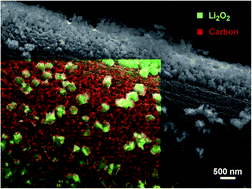Lithium–air battery cathode modification via an unconventional thermal method employing borax†
Abstract
A novel, unconventional thermal treatment employing borax for preparing porous carbon materials is presented. The new method was used to prepare carbon felt electrodes for use in lithium–air batteries. The etching of the carbon fiber surface was found to be highly controllable by the amount of borax. The resulting felts were characterized by cyclic voltammetry (CV), secondary electron microscopy (SEM), energy dispersive X-ray spectroscopy (EDX), and X-ray photoelectron spectroscopy (XPS). The borax treatment resulted in a change of the size, shape and orientation of the Li2O2 crystals formed during discharge.


 Please wait while we load your content...
Please wait while we load your content...